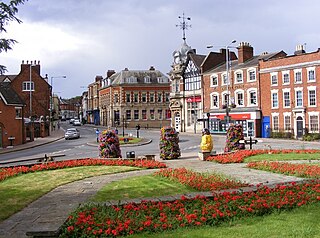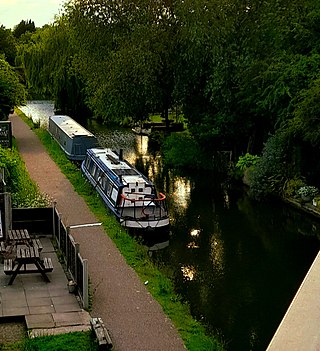
Sutton Coldfield or the Royal Town of Sutton Coldfield ( ), is a town and civil parish in the city of Birmingham, West Midlands, England. The town lies around 8 miles northeast of Birmingham city centre, 9 miles south of Lichfield, 7 miles southwest of Tamworth, and 7 miles east of Walsall.

Sutton Trinity is one of the 40 electoral wards in Birmingham, England. It is named after Holy Trinity Church, the town's parish church.

Wylde Green is a residential area within the town of Sutton Coldfield in Birmingham, England in the West Midlands. It was historically part of Warwickshire. The area is in the Sutton Vesey ward.

Boldmere is a suburb and residential area of Sutton Coldfield, City of Birmingham, England. It is bordered by New Oscott, Sutton Park, Wylde Green and Erdington, and is in the ward of Sutton Vesey.
Four Oaks is an affluent residential area in Sutton Coldfield, West Midlands, lying along the north and east borders of Sutton Park. Four Oaks is situated approximately 7+1⁄2 miles (12.1 km) north of Birmingham City Centre, and is bordered by Sutton Park, Streetly, Mere Green, Little Aston, Roughley and Aldridge. Four Oaks has a population of 21,690 as of 2004, and is part of the Sutton Four Oaks electoral ward.

Walmley is a suburban village situated in the civil parish of Sutton Coldfield, West Midlands. It lies within the City of Birmingham on its northeastern outer fringe, where it forms part of the Sutton Walmley and Minworth electoral ward. It is in southern Sutton Coldfield, close to Minworth, Erdington, Wylde Green, Pype Hayes and south of Thimble End. It is approximately 7 miles (11.3 km) northeast of Birmingham City Centre. It is the main focus of the Sutton New Hall Birmingham City Council ward.

New Hall Manor is a medieval manor house, now used as a hotel, in Sutton Coldfield, West Midlands, England.

Sutton Coldfield is a constituency represented in the House of Commons of the UK Parliament since 2001 by Andrew Mitchell, a Conservative.

John Vesey or Veysey was Bishop of Exeter from 1519 until his death in 1554, having been briefly deposed 1551–3 by King Edward VI for his opposition to the Reformation.

Maney is an area of Sutton Coldfield, Birmingham, England. It is situated close to the town centre of Sutton Coldfield and is also near Wylde Green and Walmley. The main thoroughfare is Birmingham Road, which runs through Maney.

Bishop Vesey's Grammar School (BVGS) is a selective state grammar school with academy status in Sutton Coldfield, West Midlands, England. Founded in 1527, it is one of the oldest schools in Britain, the oldest state school in the West Midlands and the third oldest school in the West Midlands after two independent schools, Bablake School and Wolverhampton Grammar School. The school had boarders until 1969 but is now a day school only.

Sutton Coldfield Town Hall is a former hotel and council building in Sutton Coldfield, Birmingham, England. The building is Grade A locally listed.

Penns Hall is a building on Penns Lane, Walmley, Sutton Coldfield, Birmingham, England, operated as a hotel and country club by Ramada International. The complex is now closed to the public due to the housing of asylum seekers. It is a Grade B locally listed building, and is licensed as a venue for civil marriages and civil partnerships.

Little Aston Hall is a Georgian country house in Little Aston, Staffordshire, England.

Moat House is a Grade II* listed building situated in Lichfield Road, Sutton Coldfield, West Midlands. It is part of the Anchorage Road conservation area.
Sir William Wilson was an English architect, builder and sculptor.
This article is intended to show a timeline of events in the History of Birmingham, England, with a particular focus on the events, people or places that are covered in Wikipedia articles.

Roughley is an electoral ward within the Royal Town of Sutton Coldfield, and is the most northerly part of the administrative area covered by the Royal Sutton Coldfield Town Council and the City of Birmingham. Over half of Roughley Ward is attractive Green Belt countryside, including arable and dairy farms, historic field boundaries survive with mature hedgerows and woodlands. Several public footpaths provide access to the countryside and the one linking Hillwood Road and Dale Farm provides distant views of Lichfield Cathedral and on a clear day the Pennine Hills.

Birmingham Metropolitan College is a further and higher education college with 10 campuses distributed within Birmingham, England. The college was created in 2009 as an amalgamation of Matthew Boulton College and Sutton Coldfield College. The main site is Matthew Boulton College based at Jennens Road in Birmingham City Centre.

Sutton Walmley and Minworth is one of 69 electoral wards in Birmingham, England.






















